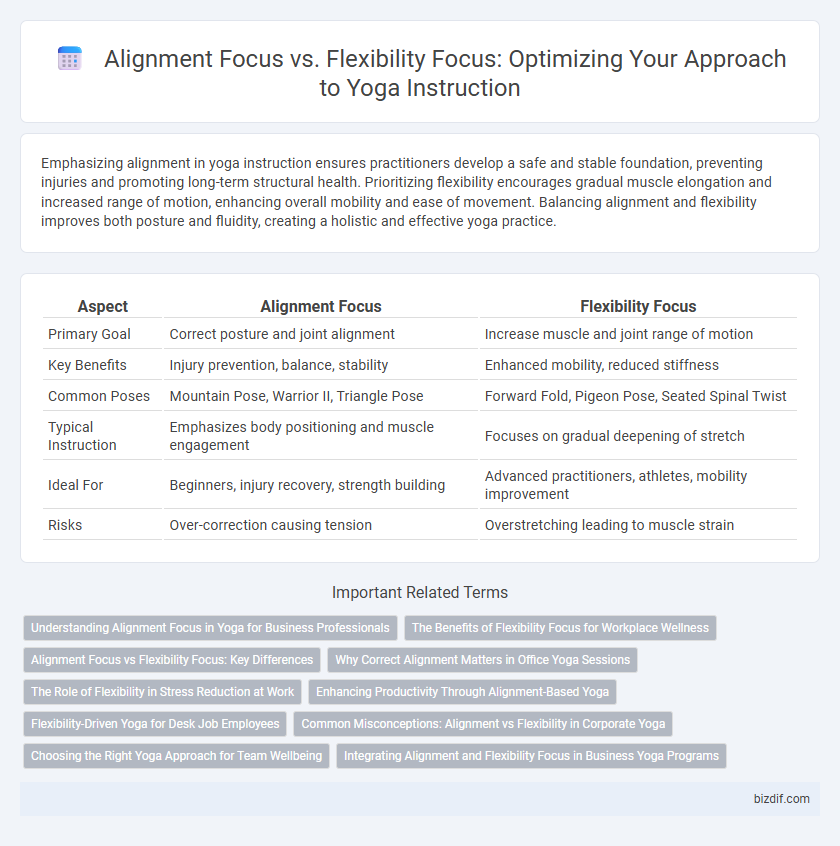Emphasizing alignment in yoga instruction ensures practitioners develop a safe and stable foundation, preventing injuries and promoting long-term structural health. Prioritizing flexibility encourages gradual muscle elongation and increased range of motion, enhancing overall mobility and ease of movement. Balancing alignment and flexibility improves both posture and fluidity, creating a holistic and effective yoga practice.
Table of Comparison
| Aspect | Alignment Focus | Flexibility Focus |
|---|---|---|
| Primary Goal | Correct posture and joint alignment | Increase muscle and joint range of motion |
| Key Benefits | Injury prevention, balance, stability | Enhanced mobility, reduced stiffness |
| Common Poses | Mountain Pose, Warrior II, Triangle Pose | Forward Fold, Pigeon Pose, Seated Spinal Twist |
| Typical Instruction | Emphasizes body positioning and muscle engagement | Focuses on gradual deepening of stretch |
| Ideal For | Beginners, injury recovery, strength building | Advanced practitioners, athletes, mobility improvement |
| Risks | Over-correction causing tension | Overstretching leading to muscle strain |
Understanding Alignment Focus in Yoga for Business Professionals
Understanding alignment focus in yoga for business professionals enhances posture, reduces stress-related muscle tension, and prevents work-induced injuries. Prioritizing precise alignment improves breathing efficiency and supports mental clarity, essential for sustained productivity in demanding work environments. This approach cultivates body awareness, enabling professionals to maintain ergonomic practices beyond the mat and optimize overall wellness.
The Benefits of Flexibility Focus for Workplace Wellness
Flexibility focus in yoga enhances workplace wellness by improving employees' range of motion, reducing muscle stiffness, and decreasing the risk of repetitive strain injuries common in desk jobs. Increased flexibility promotes better posture and circulation, leading to reduced fatigue and greater overall comfort during long work hours. Incorporating flexibility exercises in corporate wellness programs supports mental relaxation and stress relief, boosting productivity and job satisfaction.
Alignment Focus vs Flexibility Focus: Key Differences
Alignment focus in yoga emphasizes precise body positioning to prevent injuries and enhance stability, prioritizing structural integrity over range of motion. Flexibility focus centers on increasing muscle length and joint mobility, often pushing boundaries to deepen stretches and improve overall suppleness. The key difference lies in alignment ensuring safe, sustainable practice, while flexibility aims at expanding physical limits for broader movement potential.
Why Correct Alignment Matters in Office Yoga Sessions
Correct alignment in office yoga sessions is essential to prevent strain and injury caused by prolonged desk work, promoting spinal health and reducing muscle imbalances. Emphasizing alignment over flexibility ensures that exercises support joint stability and posture, leading to effective relief from tension and improved ergonomic habits. This focus enhances overall well-being and productivity by creating a sustainable practice tailored to the constraints of the office environment.
The Role of Flexibility in Stress Reduction at Work
Flexibility in yoga enhances the body's ability to release tension and improve circulation, which directly contributes to lowering stress levels during work. Proper alignment ensures safe practice, but emphasizing flexibility promotes psychological relaxation by activating the parasympathetic nervous system. Incorporating flexibility-focused poses in workplace yoga sessions supports mental clarity and reduces muscular stiffness linked to prolonged sitting.
Enhancing Productivity Through Alignment-Based Yoga
Alignment-based yoga emphasizes precise postural integrity to optimize body mechanics, reduce injury risk, and improve overall functional movement. This approach enhances productivity by promoting efficient energy use and sustained focus during physical and mental activities. Unlike flexibility-focused routines, alignment-centric practices build a stable foundation that supports long-term performance and well-being.
Flexibility-Driven Yoga for Desk Job Employees
Flexibility-driven yoga for desk job employees targets the release of tension in the hip flexors, hamstrings, and lower back caused by prolonged sitting. Emphasizing deep stretching and mobility, this approach enhances range of motion and reduces stiffness that often leads to poor posture and discomfort. Consistent practice helps counteract the physical limitations imposed by sedentary work environments, promoting overall musculoskeletal health.
Common Misconceptions: Alignment vs Flexibility in Corporate Yoga
Corporate yoga programs often emphasize flexibility, leading to the misconception that increased range of motion equals better practice. However, prioritizing alignment ensures safe posture and injury prevention by engaging proper muscle groups and joint placement. Misunderstanding the balance between alignment and flexibility can result in ineffective sessions, where participants risk strain instead of gaining strength and stability.
Choosing the Right Yoga Approach for Team Wellbeing
Choosing the right yoga approach for team wellbeing involves balancing alignment focus and flexibility focus to suit collective needs. An alignment-focused practice cultivates proper posture and injury prevention, enhancing structural awareness and long-term physical health within the team. Flexibility-focused sessions increase range of motion and stress relief, promoting relaxation and mental clarity that support overall team performance.
Integrating Alignment and Flexibility Focus in Business Yoga Programs
Integrating alignment and flexibility focus in business yoga programs enhances employee well-being by promoting posture correction alongside increased range of motion, reducing workplace injuries and discomfort. Emphasizing precise body alignment optimizes functional movement patterns, while flexibility training supports muscular balance and stress relief. This combined approach fosters a sustainable practice that improves productivity, reduces absenteeism, and cultivates mindfulness in corporate environments.
Alignment Focus vs Flexibility Focus Infographic

 bizdif.com
bizdif.com